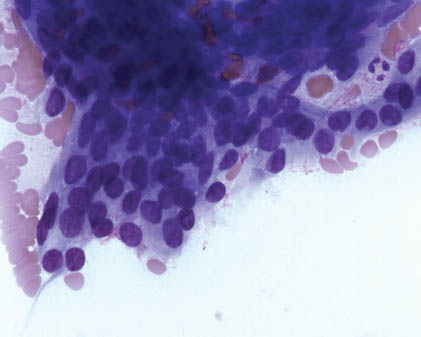CHAPTER 14
POLYMORPHOUS LOW-GRADE CARCINOMA
Polymorphous low-grade adenocarcinoma is a relatively recently described low-grade carcinoma that develops predominantly from minor salivary glands, particularly from the palate. It is characterized by cytologic uniformity and histologic diversity with infiltration to surrounding structures. It represents approximately 5% of all salivary glands tumors.
This tumor affects adults, mainly in the sixth decade, with clear female predominance. Tumor origin is almost limited to the oral cavity, palate, and upper lips. Patients present with a painless yellow, firm, mass that feels usually well circumscribed but nonencapsulated. A preexcision fine needle aspiration is not common, and in most cases, the diagnosis is made on histological examination.
14.3 CYTOLOGICAL FEATURES AND HISTOLOGICAL CORRELATES
Cytologically, smears are rich and comprise of both cellular and connective tissue components. Cells are round, observed in clusters, and occasionally isolated (Figure 14.1). The cytoplasm is usually stripped and eosinophilic. The nuclei are vescicular and clarified with delicate chromatin and minimal pleomorphism. Mitotic figures are absent. The aspirated associated stroma consists of hyaline globules similar to those of adenoid cystic carcinoma (Figures 14.2 and 14.3). They appear in eosinophilic/magenta red cores that may branch in bands with the associated epithelial papillary structures (Figure 14.3). Table 14.1 summarizes the key cytologic features.
FIGURE 14.1. High power smears with cellular clusters of cuboidal-round cells with regular and clarified nuclei and slightly ample agranular cytoplasm. The cells and nuclei are uniform and bland (May–Grünwald–Giemsa [MGG], 400×).

FIGURE 14.2. Tubular and papillary structures with magenta hyaline globules in branching bands surrounded by the associated epithelial structures (MGG, 200×).
Stay updated, free dental videos. Join our Telegram channel

VIDEdental - Online dental courses


